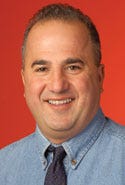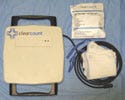RFID Edges into the Operating Room
NEWS TRENDS
October 1, 2006
|
RFID sponges could reduce OR errors, says Alex Macario. |
Using RFID to track surgical sponges could reduce one of the most deadly surgical errors: accidentally leaving those sponges in patients.
According to Alex Macario, MD, of the Stanford University Medical Center (Palo Alto, CA), each year an estimated 1500 objects are left inside patients. “Two-thirds of all objects left in the body cavity are sponges,” he says. “The risk of retention of a foreign body after surgery significantly increases in emergencies, when unplanned changes in procedure occur, and in patients with higher body-mass indexes.” Macario says that sponges could stay undiscovered in the body for decades, but they can also lead to infection, intestinal obstruction, or death.
A recent feasibility study led by Macario found that sponges embedded with RFID tags could be identified and accounted for more easily than the traditional method.
The tagged sponges, made by Clear Count Medical Systems (Pittsburgh), also include an RFID reader wand that surgical teams can pass over the body of the patient. “The system works well because it provides two types of information: it tells the reader how many items are present and what type of sponge they are,” says Gautam Gandhi, cofounder of Clear Count. Macario explains that the tags are programmed with certain types of data, including the type of sponge, inventory number, and date of manufacture.
|
The Clear Count RFID system includes a reader wand to identify the sponges. |
Traditional methods for ensuring that all objects are removed include counting gauze and sponges before surgery by hand and continuing the count as more sponges are needed during the surgery. A second count is made at the beginning of the wound closure, and then a final count is done once the skin is closed. Obviously, in a busy operating room, such counts are unreliable, even with the most conscientious surgical staff. Therefore, says Macario, all high-risk surgeries are followed by a mandatory x-ray to ensure the patient is clear, regardless of the count outcome.
Gandhi explains that x-rays require expensive machines and hospitals may not have the capacity to meet such demand. “Hospitals don't have a dedicated x-ray machine for counting foreign bodies, and only a radiologist can interpret the image. The RFID method is meant to be used in lieu of an x-ray and with immediate results.
“Because the sponges are used so readily, we only had to secure biocompatibility and electromagnetic compatibility studies for the RFID tags,” he says. Gandhi highlights some of the benefits of the RFID sponges including the following:
|
Each RFID tag is the size of a penny and contains no batteries. |
• The tags are passive. They are nonemitting and contain no batteries.
• Each tag is the size of a penny. (During the study, Macario used an earlier tag design that was slightly smaller than a nickel.)
• No line-of-sight is required to detect sponges.
• The wand can read multiple sponges simultaneously.
• Individual tagging prevents surgeons from counting the same sponge twice.
When the device industry talks about the future of RFID, says Gandhi, most of the conversation centers on infrastructure issues such as patient tracking or drug administration. But such applications are considered to be far in the future, because most RFID systems require an overhaul of the hospital. “Most people think RFID systems are about infrastructure, and that these systems are expensive and take time to use,” Gandhi says. “What is novel about this system is that it can be used right away.”
Of course, says Gandhi, it cannot be used yet for every foreign body: “We did not try to create RFID systems for other surgical tools, although that is a possibility for the future.” Macario agrees. “Tagging a small pair of steel scissors, for example, needs further development work. Further testing in a variety of surgeries may be needed. We also need to obtain feedback from users to see what kind of detection system—wand or something else—works best.”
Macario also says that the system users need training before the device can be effective. “When we started, I was concerned about the technological part of the problem,” he says. “But our study found the device works 100% of the time.”
The real challenge, says Macario, is how to incorporate a new device into the work flow of the operating room. “We need a system that is really fail-safe, where, regardless of how people use counting-system technology, the patient doesn't leave the operating room with a retained foreign body. For example, if the operating room personnel doesn't do a scan of the patient's surgery site with the wand—maybe the surgery case is very complicated—then the risk of retained foreign bodies persists. Training may help, but the whole method for keeping track of items may also need to be redesigned.”
Copyright ©2006 Medical Device & Diagnostic Industry
About the Author(s)
You May Also Like





